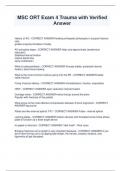Samenvatting
Corporate Communication Book Summary
- Instelling
- Universiteit Van Amsterdam (UvA)
This extensive summary contains all the chapters covered from week 1 to 7. It has 57 pages and entails all the important theories and concepts that will prepare you for the exam.
[Meer zien]













